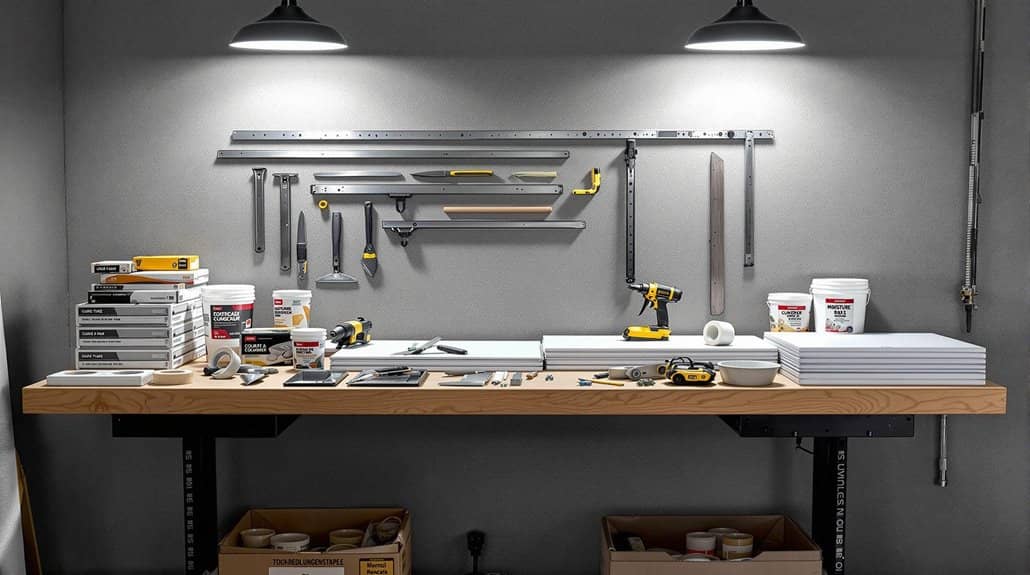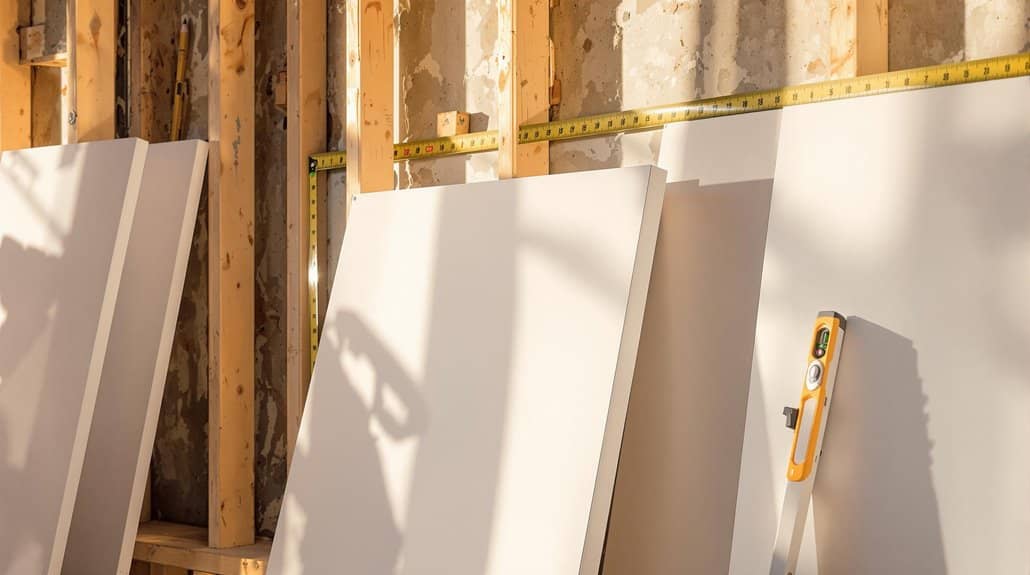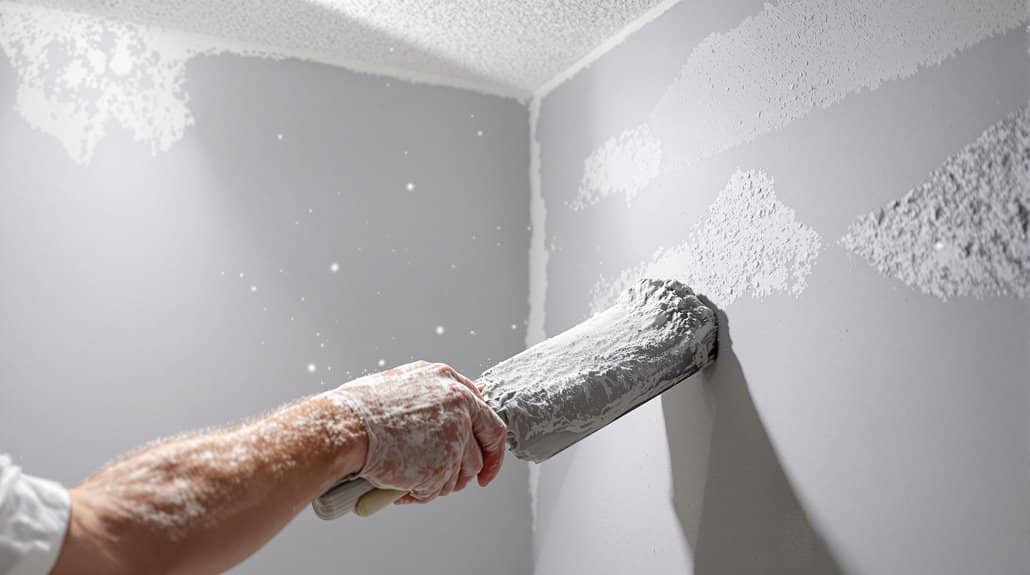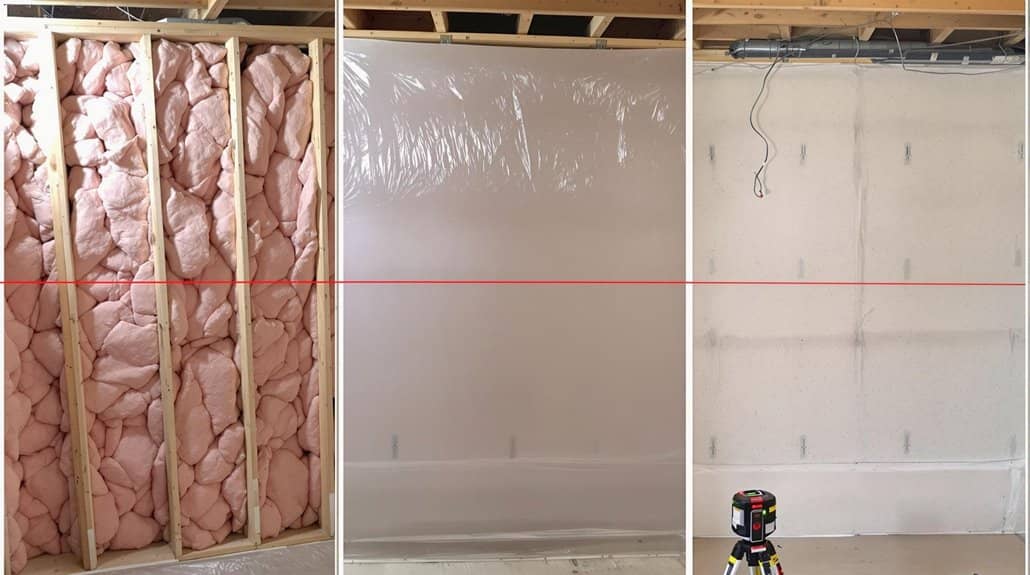To master basement drywall installation in Calgary, you’ll need to account for the city’s unique climate challenges, including -8°C winters and 460mm annual precipitation. Start with crucial tools: a reliable drywall lift, moisture-resistant panels, and proper safety gear. Install a continuous vapor barrier before hanging sheets, and maintain precise 12-16 inch screw spacing for ideal support. You’ll find success in the details of proper measuring, cutting, and moisture control techniques that follow.
Key Takeaways
- Install moisture-resistant drywall with proper vapor barriers to combat Calgary’s 460mm annual precipitation and protect against basement dampness.
- Maintain precise screw spacing of 12-16 inches and stagger joints between rows for optimal structural support in basement conditions.
- Use specialized moisture-resistant insulation and continuous vapor barriers on warm sides to prevent condensation during Calgary’s cold winters.
- Budget between $3,000-$10,000 for complete basement drywall installation, including materials and professional labor in Calgary’s market.
- Follow local building codes for material selection and installation methods while ensuring proper ventilation systems for moisture control.
Essential Tools and Materials for Calgary Basement Drywalling

Successful basement drywall installation starts with assembling the right tools and materials for the job. You’ll need crucial tools including a reliable drywall lift, which proves invaluable for single-handedly positioning panels. A sharp utility knife paired with a T-square guarantees precise cuts and proper measurements throughout your project.
For materials, select standard drywall sheets for general use and moisture-resistant panels for areas susceptible to humidity. Don’t forget to invest in a drywall saw for cutting outlet holes and a sanding pole for achieving professional-grade finishes. Your shopping list should include drywall-specific screws, joint tape, and compound for seamless joints. Ultimately, protect yourself with safety gear – goggles, dust masks, and knee pads are non-negotiable when working in confined basement spaces. A stud finder is essential for accurately marking support beam locations before beginning installation.
Understanding Calgary’s Climate Impact on Drywall Installation
While Calgary’s unique climate presents distinct challenges for basement renovations, understanding its impact on drywall installation is crucial for long-term success. You’ll need to account for moisture levels and temperature fluctuations that can affect your basement’s integrity throughout the year.
- Your drywall installation must incorporate moisture-resistant materials to combat Calgary’s annual precipitation of 460mm, preventing mold growth and structural deterioration.
- You’ll want to guarantee proper insulation behind the drywall to maintain energy efficiency during -8°C winter temperatures.
- Building codes in Calgary require specific materials and installation methods – staying compliant protects your investment.
- Calgary’s dry air can cause drywall cracking, so you’ll need precise measuring and professional taping techniques for ideal results.
Understanding these climate-specific considerations will help you create a durable, code-compliant basement space that withstands local weather conditions. Selecting moisture-resistant green board or other specialized drywall options helps protect against variable water tables and crawl space issues common in Calgary basements.
Proper Measurement and Layout Techniques

Having addressed Calgary’s climate considerations, let’s focus on the foundation of quality drywall installation: precise measurements and layout planning. You’ll need to start with proper measurement techniques, using your level to mark vertical guidelines on studs while maintaining consistent spacing for ideal support.
| Measurement Step | Tool Required | Key Consideration |
|---|---|---|
| Wall Length | Tape Measure | Account for corners |
| Height | Level | Floor to ceiling |
| Opening Layout | Square | Windows and doors |
Your success depends on accurate calculations before making any cuts. You’ll want to measure twice and cut once, ensuring each panel fits perfectly around obstacles while maintaining proper screw spacing at 12-16 inches apart. This methodical approach saves materials and time while delivering professional results that you’ll be proud to showcase in your basement renovation project. Moisture-resistant drywall products are essential for Calgary basements to prevent mold growth and ensure long-term durability.
Professional Tips for Cutting and Hanging Drywall Sheets
Expert craftsmen know that cutting and hanging drywall sheets demands precision and the right technique. When you’re tackling expert drywall installation, you’ll need to focus on clean cuts and proper mounting methods to attain professional results.
- Score your drywall’s front side using a utility knife and straightedge, then snap along the cut line for precise edges
- Maintain 12-inch screw spacing at edges and 16-inch spacing in the field to prevent sagging
- Always stagger joints between rows to boost structural integrity and minimize crack formation
- Use a drywall lift or partner when hanging sheets to guarantee proper alignment with ceilings and walls
Remember to apply joint compound with a 10-inch taping knife, feathering the edges for seamless results. These techniques will help you attain the high-quality finish that distinguishes professional installations from amateur work. Our team’s perfectionist approach ensures every cut and installation meets rigorous quality standards for lasting durability.
Mastering Joint Taping and Mud Application

Successful joint taping and mud application form the backbone of a flawless drywall finish. You’ll need to start by applying drywall tape over all seams and corners, ensuring proper adhesion for professional-quality results. When performing drywall taping, remember to apply your joint compound in multiple thin layers rather than one thick coat. Our experienced technicians are trained specifically for precision taping and mud application to deliver superior results. Begin with a 6-inch knife for your initial mud application, then graduate to wider knives for subsequent layers to create seamless, feathered edges. You’ll want to sand between each layer of compound, eliminating imperfections that could compromise your finish. Always allow 24 hours of drying time between coats, depending on your basement’s conditions. If you’re unsure about tackling this vital step, consider professional repair services to achieve that perfect, crack-free finish your basement deserves.
Common Basement Moisture Challenges and Solutions
After perfecting your taping and mudding technique, moisture protection becomes your next major focus. Basement moisture issues can quickly compromise your drywall installation if not properly addressed. You’ll need to implement thorough moisture control strategies to guarantee your investment’s longevity.
To effectively protect your basement drywall:
- Install moisture-resistant drywall specifically designed for high-humidity environments
- Apply a continuous vapor barrier before installation to prevent moisture penetration
- Incorporate proper insulation, such as spray foam, to regulate temperature and minimize condensation
- Maintain regular inspections of potential leak points and ventilation systems
These protective measures work together to create a moisture-resistant barrier system. Remember, prevention is more cost-effective than repairs, and implementing these solutions during installation will greatly extend your drywall’s lifespan while maintaining ideal basement conditions.
For optimal results, consider consulting Calgary Drywall Doctors for a professional assessment of your basement’s specific moisture control needs.
Best Practices for Insulation and Vapor Barriers

While basement drywall installation requires precision, proper insulation and vapor barrier placement serve as the foundation for long-term performance. You’ll need to select moisture-resistant insulation materials and establish a continuous vapor barrier on the warm side to protect against humidity. Don’t forget to seal all seams with appropriate tape or adhesive. The cost per square foot for a complete basement drywall project typically ranges from $3000-$10000, including materials and labor.
| Component | Best Practice | Key Benefit |
|---|---|---|
| Insulation | Moisture-resistant | Prevents dampness |
| Vapor Barrier | Warm-side installation | Blocks moisture penetration |
| Seams | Tape/adhesive sealing | Maintains barrier integrity |
| Drywall | Insulated products | Improved thermal efficiency |
| Installation | Code compliance | Safety and durability |
Consider using insulated drywall products to optimize your basement’s thermal performance while simplifying the installation process. Remember to verify local building codes to confirm your installation meets all regulatory requirements.
Frequently Asked Questions
How Much Does It Cost to Put up Drywall in Basement?
You’ll spend between $1.50-$3.00 per square foot on drywall installation, with cost factors including materials and labor. For a 1,000-square-foot basement, expect to pay $1,500-$3,000, plus finishing costs.
How Much Does It Cost to Install Drywall in Calgary?
You’ll typically pay $1.50-$3.50 per square foot for drywall installation in Calgary, with cost factors including labor ($30-$70/hour), material type, and finishing work. Total project expenses generally range from $1,500-$3,500.
What Drywall Should I Use in My Basement?
You’ll want moisture-resistant drywall (greenboard) for areas prone to dampness, and consider pairing it with insulated drywall panels for basement insulation. Fire-resistant options are also smart for added safety and code compliance.
Can You Put Drywall in a Basement?
Yes, you can install drywall in your basement, but you’ll need moisture-resistant materials to prevent damage. While there are drywall alternatives available, proper moisture control and ventilation are crucial for successful basement finishing.
Conclusion
Mastering basement drywall installation in Calgary’s unique climate requires your strict attention to moisture control and proper vapor barrier installation. You’ll need to maintain consistent spacing, use moisture-resistant materials, and guarantee thorough joint taping to prevent future issues. By following these climate-specific guidelines and technical installation protocols, you’ll achieve a professional-grade finish that withstands Calgary’s temperature fluctuations and moisture challenges.





